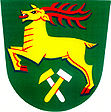Žďárky
| Žďárky | ||||
|---|---|---|---|---|
|
||||
| Basic data | ||||
| State : |
|
|||
| Region : | Královéhradecký kraj | |||
| District : | After that | |||
| Area : | 458 ha | |||
| Geographic location : | 50 ° 28 ' N , 16 ° 14' E | |||
| Height: | 397 m nm | |||
| Residents : | 552 (Jan. 1, 2019) | |||
| Postal code : | 549 37 | |||
| structure | ||||
| Status: | local community | |||
| Districts: | 1 | |||
| administration | ||||
| Mayor : | Vladimír Jerman (as of 2007) | |||
| Address: | Žďárky 35 549 37 Žďárky |
|||
| Municipality number: | 574694 | |||
| Website : | www.obeczdarky.cz | |||
Žďárky ( German small fire ) is a municipality in the Czech Republic . It is located three kilometers southeast of Hronov at 397 m above sea level. M. on the border with Poland and belongs to the Okres Náchod .
geography
The village is situated on the western slopes of Table Mountains in the valley of the river Brlenka the east of Vysoká Srbská springs and south of Brné in the Czermnica ( Czech heritage Neyer stream flows).
Neighboring places are in the southwest Velké Poříčí , in the west Hronov, in the north Zlíčko and Závrchy and on the Polish side in the east Pstrążna and in the southeast Czermna .
history
The Žďárky belonging to the Nachod rule was first mentioned in 1415. In earlier times it was on the road from Nachod via Schlaney and Politz to Braunau , as the current connection to the right of the Metuje ( Mettau ) did not yet exist. It was only created after Prussia took possession of the County of Glatz in 1763 and parts of the previous route to the left of the Mettau were now across the Prussian border. As a result, Žďárky got into a remote border situation. The new demarcation also meant that Žďárky, which had belonged to the parish of St. Bartholomew in Tschorbeney since ancient times , was repared to the parish of Hronov in 1780.
In 1794 394 inhabitants lived in Žďárky. A few years later, the new owner of the Nachod estate , Duke Peter von Biron , initiated the establishment of a village school. He also introduced relief in the labor market. In 1848 the manor was dissolved. During the mining period, Žďárky had over 1000 inhabitants.
After the Second World War , the border with the now Polish Pstrążna was closed in 1945 and only reopened when the two countries joined the Schengen area in 2007.
Mining
Until the 18th century, the inhabitants mainly earned their living as house weavers, small farmers or day laborers. This changed when a coal deposit was discovered on the Heideberg ( Borek ) in the valley of the Strausseneyer brook ( Strouženský potok , Polish Pstrążnik ) near Bühlfeld ( Závrchy ). The dismantling took place in the Neue Barbara-Grube and the Josef-Grube . The coal was used, among other things, to burn the bricks that were needed to build the Josefstadt fortress .
After previous investigations by the Hronow shift supervisor Georg Michael Franke, the Wilhelmine mine was opened in 1805 on what is now the Prussian border. The mine was named after the owner of the Nachod estate, Wilhelmine von Sagan . In 1834 the Wilhelminen mine was connected to the Rosalie and Hůrka mines , which were located on the Prussian side near Straußeney. In 1836 the mining right was leased for ten years to the then Hronov pastor and later dean of Nachod, Josef Regner , who, however, could not record any economic success. The writer Alois Jirásek vividly processed this period in the history of the mine in Volume 3 ( Osetek ) of his novel “U nás”, in which Regner is referred to as Havlovicky ( after his place of birth ) . Since Jirásek asked relatives and other contemporary witnesses in the area during his research, his portrayal should be authentic.
In 1846, the Wilhelmina Mine was shut down for unknown reasons and then sold because the Náchod rule on the more profitable mines on Falk Mountains involved. The operation of the Wilhelminen mine was resumed after frequent changes of ownership, but remained unprofitable, so that operations were discontinued in 1904. From 1907 to 1922 coal was mined again. On February 22, 1925, the headframe was turned down. In Straußeney, too, coal mining had ceased in 1929.
Attractions
- On the right bank of the Brlenka above the school there are five ash trees ( Bartoňovy jasany ), which have been protected as a tree monument since 2002 .
Personalities
- Josef Bartoň-Dobenín (1838–1920), textile entrepreneur
- Josef Bartoň-Dobenín (1862–1951), textile entrepreneur
- Cyril Bartoň-Dobenín (1863–1953), textile entrepreneur
literature
- Lydia Baštecká, Ivana Ebelová: Náchod . Náchod 2004, ISBN 80-7106-674-5
- Alois Jirasek, U nás . 4 vols., Prague 1927
Web links
- Website of the municipality of CZ
- Website about the coal mining between Kleinbrand and Straußeney CZ
Individual evidence
- ↑ Český statistický úřad - The population of the Czech municipalities as of January 1, 2019 (PDF; 7.4 MiB)
- ↑ Lydia Baštecká, Ivana Ebelová: Náchod . Náchod 2004, p. 47.
- ↑ Lydia Baštecká, Ivana Ebelová: Náchod . Náchod 2004, p. 129.
- ↑ Tree monument

